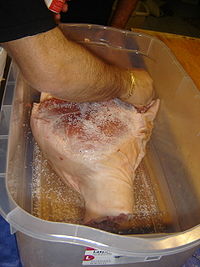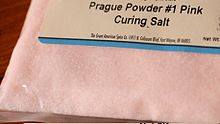- Curing (food preservation)
-
Curing refers to various food preservation and flavoring processes, especially of meat or fish, by the addition of a combination of salt, nitrates, nitrite[1] or sugar. Many curing processes also involve smoking, the process of flavoring, cooking, or preserving food by exposing it to the smoke from burning or smoldering plant materials, most often wood. The use of food dehydration was the earliest form of food curing.[1]
Contents
History
Food curing dates back to ancient times, both in the form of smoked meat and as salt-cured meat.[2] The Plains Indians used to hang their meat at the top of their teepees to increase the amount of smoke coming into contact with the food.[2] It was discovered in the 1800s that salt mixed with nitrites (saltpeter) would color meats red, rather than grey, and consumers at that time then strongly preferred the red-colored meat.[1]
Chemical actions
Salt
Table salt (sodium chloride) is the primary ingredient used in meat curing.[2] Removal of water and addition of salt to meat creates a solute-rich environment where osmotic pressure draws water out of microorganisms, retarding their growth.[2][3] Doing this requires a concentration of salt of nearly 20%.[3] In addition, salt causes the soluble meat proteins to come to the surface of the meat particles within sausages. These proteins coagulate when the sausage is heated, helping to hold the sausage together.[4] Finally, salt slows the oxidation process, effectively preventing the meat from going rancid.[3]
Sugar
The sugar added to meat for the purpose of curing it comes in many forms, including honey, corn syrup solids, and maple syrup.[5] However, with the exception of bacon, it does not contribute much to the flavor,[6] but it does alleviate the harsh flavor of the salt.[2] Sugar also contributes to the growth of beneficial bacteria like Lactobacillus by feeding them.[7]
Nitrates and nitrites
Nitrates and nitrites not only help kill bacteria, but also produce a characteristic flavor and give meat a pink or red color.[8] Nitrate (NO3−), generally supplied by sodium nitrate or potassium nitrate, is used as a source for nitrite (NO2−). The nitrite further breaks down in the meat into nitric oxide (NO), which then binds to the iron atom in the center of myoglobin's heme group, reducing oxidation and causing a reddish-brown color (nitrosomyoglobin) when raw, and the characteristic cooked-ham pink color (nitrosohemochrome or nitrosyl-heme) when cooked. The addition of ascorbate to cured meat reduces formation of nitrosamines, but increases the nitrosylation of iron. The use of nitrates in food preservation is controversial, though, due to the potential for the formation of nitrosamines when the preserved food is cooked at high temperature.[8] The usage of either compound is therefore carefully regulated; for example, in the United States, the concentration of nitrates and nitrites is generally limited to 200 ppm or lower.[8] However, they are considered irreplaceable in the prevention of botulinum poisoning from consumption of cured dry sausages by preventing spore germination.[9]
A 2007 study by Columbia University suggests a link between eating cured meats and chronic obstructive pulmonary disease. Nitrites were posited as a possible cause.[10]
Smoke
Meat can also be preserved by smoking, which is to cook the meat in the presence of smoke. (Thus, the meat is usually near a fire.) Slow-cooking meat while smoking it will also keep it tender.[11] One method of smoking calls for a smokehouse with damp wood chips or sawdust.[12]
See also
Notes
- ^ a b c "Historical Origins of Food Preservation." University of Georgia, National Center for Home Food Preservation. Accessed June 2011.
- ^ a b c d e Ray, Frederick K.. Oklahoma Cooperative Extension Service (Report). Oklahoma State University. http://pods.dasnr.okstate.edu/docushare/dsweb/Get/Document-2055/ANSI-3994web.pdf. Retrieved 15 December 2010.
- ^ a b c "Curing and Brining (food preservation)". Science of Cooking. Minnesota State University. http://www.mnstate.edu/provost/BCBT100%20Curing%20and%20Brining.pdf. Retrieved 15 December 2010.
- ^ "Curing & Smoking". National Center for Home Food Preservation. University of Georgia. http://www.uga.edu/nchfp/how/cure_smoke/sausage_ingredients.html. Retrieved 15 December 2010.
- ^ "Additives Used in Meat". Meat Science. Illinois State University. http://labs.ansci.illinois.edu/meatscience/Library/additives.htm. Retrieved 16 December 2010.
- ^ "Smoking and Curing". The National Center for Home Food Preservation. University of Georgia. http://www.uga.edu/nchfp/publications/nchfp/lit_rev/cure_smoke_cure.html. Retrieved 16 December 2010.
- ^ "What Is Curing?". Science of Cooking. EDinformatics. http://www.edinformatics.com/math_science/science_of_cooking/curing_foods.htm. Retrieved 16 December 2010.
- ^ a b c "Curing Food". Edinformatics. http://www.edinformatics.com/math_science/science_of_cooking/curing_foods.htm. Retrieved 21 February 2010.
- ^ De Vries, John (1997). Food Safety and Toxicity. CRC Press. p. 70. ISBN 9780849394881.
- ^ "Health | Too much bacon 'bad for lungs'". BBC News. 2007-04-17. http://news.bbc.co.uk/2/hi/health/6560121.stm. Retrieved 2010-07-16.
- ^ "Smoking Meat and Poultry". Fact Sheets. United States Department of Agriculture. http://www.fsis.usda.gov/factsheets/Smoking_Meat_and_Poultry/index.asp. Retrieved 27 January 2011.
- ^ Busboom, Jan R.. "Curing and Smoking Poultry Meat". Washington State University. http://cru.cahe.wsu.edu/CEPublications/eb1660/eb1660.pdf. Retrieved 27 January 2011.
References
- McGee, Harold. On Food and Cooking (revised). New York, NY: Scribner, 2004. ISBN 0-684-80001-2
- Bertolli, Paul. Cooking by Hand. New York, NY: Clarkson Potter/Publishers, 2003. ISBN 0-609-60893-2
- National Research Council Academy of Life Sciences. "The Health Effects of Nitrate, Nitrite and N-Nitroso Compounds". Washington DC: National Academy Press, 1981.
- Article in The Scientist, Volume 13, No. 6:1, Mar. 15, 1999 (registration required).
External links
Food preservation Biopreservation · Canning · Cold chain · Curing · Drying · Fermentation · Freezing · Freeze drying · Hurdle technology · Irradiation · Jamming · Jellying · Jugging · Modified atmosphere · Pickling · Potting · Pressure · Salting · Smoking · Sugaring · Vacuum packingCooking techniques Dry ConductionConvectionRadiationWet High heatLow heatIndirect heatFat-based High heatBlackening · Browning · Frying (Deep frying · Pan frying · Shallow frying · Stir frying (bao)) · SautéingLow heatMixed medium Device-based Non-heat See also Categories:- Food preservation
- Cooking techniques
- Garde manger
Wikimedia Foundation. 2010.



